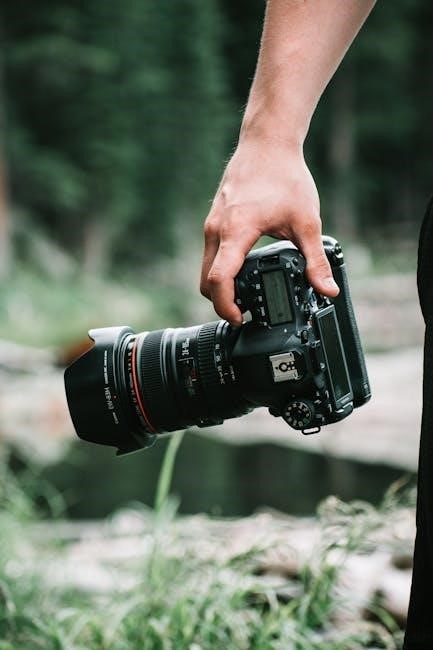The Nikon F3‚ introduced in 1980‚ is a professional SLR camera renowned for its durability and advanced features. It was the first Nikon professional camera to rely entirely on battery power‚ offering manual shutter control‚ compatibility with a wide range of lenses‚ and interchangeable viewfinders. This landmark model set new standards in photography.
1.1 Overview of the Nikon F3
The Nikon F3‚ introduced in 1980‚ is a landmark professional SLR camera that set new standards in photography. Designed by the renowned Italian designer Giorgetto Giugiaro‚ the F3 combines durability‚ advanced features‚ and intuitive controls. It was the first professional Nikon camera to rely entirely on battery power for all functions‚ marking a significant shift in camera design. The F3 is known for its robust titanium body‚ enhanced durability‚ and compatibility with a wide range of Nikon lenses and accessories.
The camera offers manual and automatic exposure control‚ with shutter speeds ranging from 1/2000 sec. to 8 sec.‚ including Bulb (B) and Time (T) modes. Its interchangeable viewfinders provide flexibility for different shooting needs‚ while the high-eyepoint design ensures comfort during extended use. The F3 is compatible with all Nikkor and Nikon Series E lenses‚ making it a versatile tool for photographers. The user manual plays a crucial role in unlocking the camera’s full potential‚ detailing its operation‚ features‚ and maintenance.
With its timeless design and professional-grade performance‚ the Nikon F3 remains a celebrated choice among photographers‚ both for its functionality and historical significance in the evolution of SLR cameras. This overview highlights the F3’s key attributes‚ setting the stage for a deeper exploration of its features and operation in subsequent sections.
1.2 Importance of the User Manual
The Nikon F3 user manual is an indispensable resource for photographers seeking to maximize the camera’s capabilities. As a professional-grade SLR‚ the F3 offers a wide range of advanced features that require a thorough understanding to operate effectively. The manual provides detailed explanations of the camera’s functions‚ allowing users to unlock its full potential and tailor settings to their specific needs.
For both novice and experienced photographers‚ the manual serves as a comprehensive guide to understanding the F3’s intricate systems. It explains how to customize settings‚ use interchangeable viewfinders‚ and optimize lens performance. Additionally‚ the manual includes troubleshooting tips and maintenance advice‚ ensuring the camera remains in optimal condition. By following the manual‚ users can avoid common mistakes and ensure their equipment is used safely and efficiently.
Moreover‚ the manual offers insights into advanced shooting techniques‚ helping photographers refine their skills. Whether capturing landscapes‚ portraits‚ or action shots‚ the manual provides guidance on how to achieve the best results with the F3. Its clear‚ step-by-step instructions make it an essential companion for anyone looking to master this iconic camera.
1.3 Structure of the Manual
The Nikon F3 user manual is meticulously organized to ensure ease of navigation and comprehension. The manual is divided into clear‚ logical sections‚ each addressing specific aspects of the camera’s operation and functionality. This structured approach allows users to quickly locate the information they need‚ whether they are familiar with the camera or exploring its features for the first time.

The manual begins with an introduction to the Nikon F3‚ providing an overview of the camera’s design and its significance in the world of photography. This is followed by a detailed breakdown of the camera’s key features‚ including its design‚ shutter speed control‚ viewfinder options‚ and lens compatibility. These sections are designed to familiarize users with the camera’s capabilities and how to utilize them effectively.
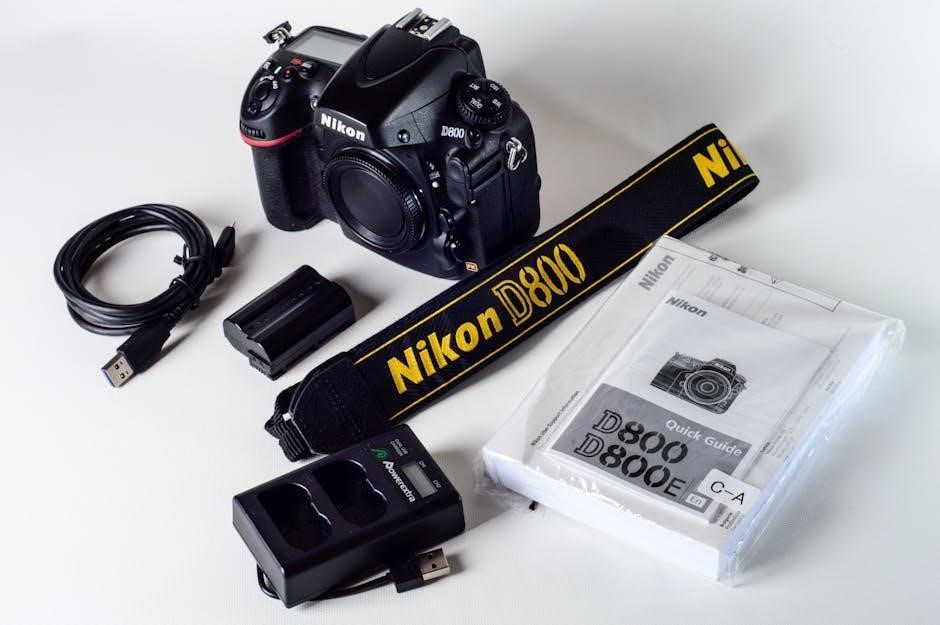
The manual then progresses to a thorough explanation of the camera’s parts and controls‚ ensuring users understand the purpose and function of every component. This is complemented by a section on basic operation‚ which guides users through the fundamental steps of using the camera‚ from powering it on to setting up for a shoot.
Additional sections cover advanced techniques‚ maintenance‚ and troubleshooting‚ providing users with the knowledge to optimize their photography experience. The manual also includes appendices with technical specifications‚ ensuring that users have access to all the information they need in one comprehensive resource.
The clear and methodical structure of the manual makes it an invaluable tool for photographers of all skill levels‚ helping them unlock the full potential of the Nikon F3 and achieve exceptional results in their work.
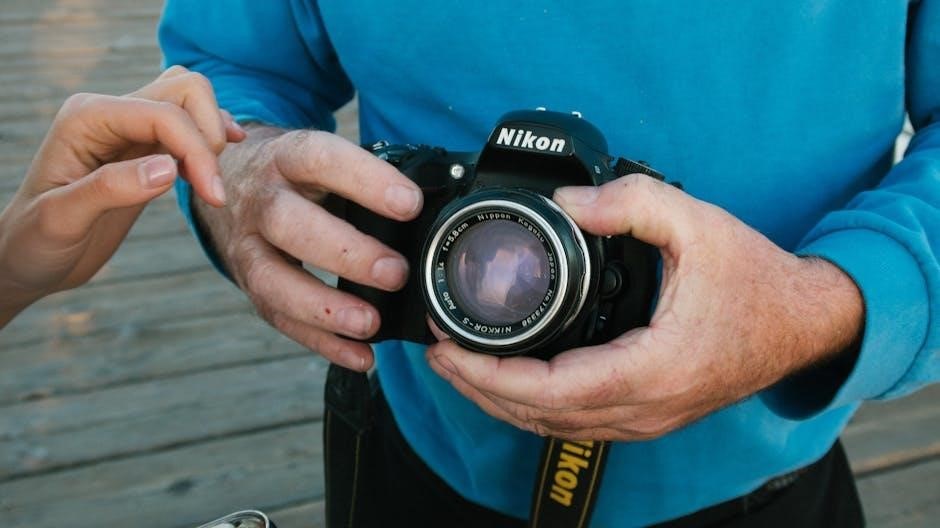
Key Features of the Nikon F3
The Nikon F3 is a high-end SLR camera renowned for its robust build‚ reliability‚ and advanced features. It boasts an electronic shutter‚ aperture-priority auto mode‚ and center-weighted metering. The camera also offers interchangeable viewfinders‚ manual focus control‚ and compatibility with a wide range of Nikon lenses‚ making it versatile for professional photographers.
2.1 Design and Build Quality
The Nikon F3 is celebrated for its exceptional design and build quality‚ reflecting Nikon’s commitment to durability and precision engineering. The camera’s chassis is crafted from a robust copper silumin alloy‚ ensuring strength while maintaining a manageable weight. The body is weather-sealed to withstand harsh environments‚ making it a reliable tool for professional photographers in demanding conditions.
The ergonomic design of the F3 emphasizes comfort and intuitive handling. The contoured grip and balanced weight distribution allow for extended use without fatigue. Buttons and dials are strategically placed for easy access‚ reducing the learning curve for both novice and experienced users. This thoughtful design ensures that the camera feels like an extension of the photographer’s hand.
Nikon’s attention to detail is evident in the F3’s construction. The camera’s components‚ from the shutter curtain to the lens mount‚ are built to last‚ with a focus on precision and reliability. The F3’s design has stood the test of time‚ earning it a reputation as one of the most rugged and user-friendly cameras in its class. Its build quality not only inspires confidence but also ensures that the camera remains a trusted companion for years of photography.
2.2 Shutter Speed Control
The Nikon F3 features a highly advanced shutter speed control system designed to provide photographers with precise control over exposure. The camera utilizes a horizontally traveling cloth focal-plane shutter‚ which is renowned for its durability‚ quiet operation‚ and minimal vibration. This design ensures sharp images even at slower shutter speeds‚ making it ideal for handheld shooting and low-light conditions.
The F3 offers a wide range of shutter speeds‚ from 8 seconds down to 1/2000th of a second‚ in increments of 1/2 or 1/3 stops. Additionally‚ the camera includes a Bulb (B) mode for extended exposures‚ allowing photographers to capture creative effects such as star trails or light painting. The shutter is synchronized with the electronic flash at speeds up to 1/60th of a second‚ ensuring proper illumination in flash photography.
The shutter speed control is mechanically linked to the camera’s aperture system‚ allowing for seamless integration between exposure components. The F3 also features a stepless aperture control in Manual mode‚ enabling photographers to adjust the aperture smoothly without discrete clicks‚ which is particularly useful for video applications. The camera’s shutter mechanism is built to last‚ with a reputation for reliable performance even after extensive use.
For added convenience‚ the F3 includes a shutter speed lock to prevent accidental changes‚ and the shutter release button is equipped with a threaded cable release socket for remote operation. These features‚ combined with the camera’s robust construction‚ make the F3 a versatile and dependable tool for photographers seeking precise control over their exposures.
2.3 Viewfinder Options
The Nikon F3 offers a versatile and customizable viewfinder system‚ designed to meet the needs of professional photographers. The camera features an interchangeable viewfinder mechanism‚ allowing users to choose from a variety of optional finders tailored to specific shooting requirements. The standard viewfinder is the DE-3‚ which provides a clear‚ bright view of the scene with 100% frame coverage and 0.7x magnification‚ making it ideal for precise composition.
For photographers who prefer a different viewing experience‚ the F3 supports additional viewfinders such as the DE-2 and DA-2. The DE-2 finder includes an LCD display that shows critical exposure information‚ including shutter speed‚ aperture‚ and exposure compensation‚ allowing for quick adjustments without taking the eye away from the viewfinder. The DA-2 finder‚ on the other hand‚ offers a simplified‚ non/LCD display with illuminated frame lines‚ catering to those who prefer a more minimalist approach.
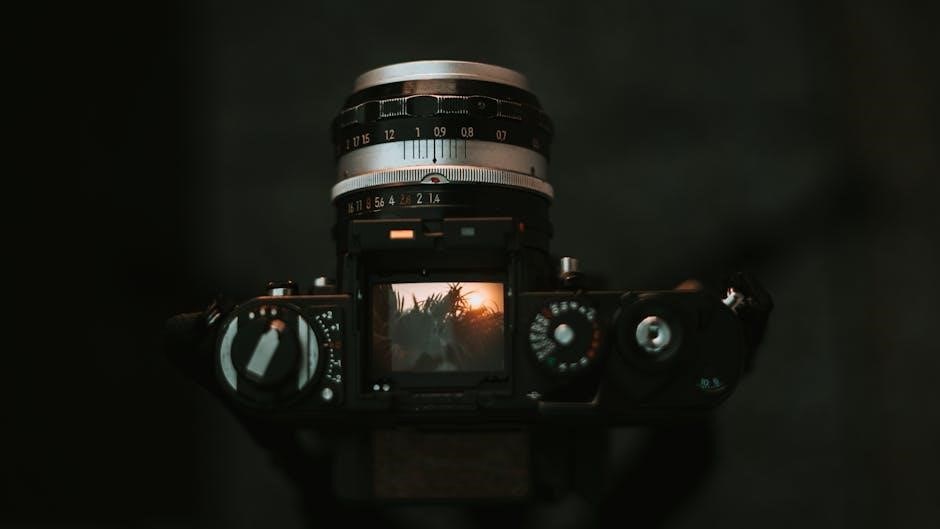
All viewfinders for the F3 are designed with a focus on clarity and comfort‚ featuring adjustable diopter correction to accommodate photographers with different vision needs. The viewfinder’s eyepiece is also equipped with a rubber eyecup to reduce glare and improve visibility in bright lighting conditions. This modular system ensures that the F3 can adapt to various shooting styles and preferences‚ making it a highly flexible tool for professional and enthusiast photographers alike.
With its interchangeable viewfinders‚ the Nikon F3 provides unparalleled customization‚ enabling photographers to optimize their workflow and focus on capturing the perfect shot without compromise.
2.4 Lens Compatibility
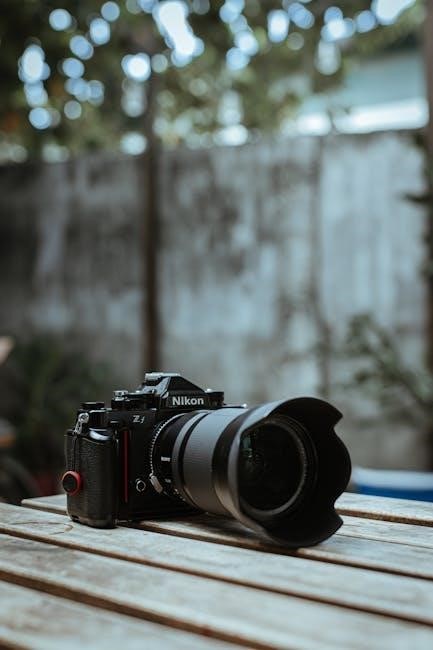
The Nikon F3 is renowned for its exceptional lens compatibility‚ thanks to the Nikon F-mount system‚ which has been a cornerstone of Nikon’s lens lineup for decades. This compatibility allows photographers to utilize a vast array of lenses‚ ensuring versatility and meeting the diverse needs of photographic applications.

The F3 is compatible with Nikon’s AI (Automatic Indexing) and AIS (Automatic Indexing Special) lenses‚ which were introduced in the 1970s and 1980s. These lenses are designed to provide precise aperture control and metering capabilities. Additionally‚ the F3 can also be used with older non-AI lenses‚ although some may require manual stop-down metering to ensure accurate exposure readings.
Mounting a lens on the F3 is a straightforward process. The lens is aligned with the camera’s F-mount and twisted clockwise until it clicks into place. The lens release button‚ located on the front of the camera‚ allows for quick and easy removal of the lens. This secure mounting system ensures that the lens remains firmly attached during use‚ even with heavy telephoto lenses.
The F3’s compatibility with a wide range of lenses makes it a highly versatile camera‚ capable of handling everything from wide-angle landscapes to high-magnification wildlife photography. This adaptability has made the F3 a favorite among photographers who value the ability to use high-quality optics across different generations of Nikon lenses.
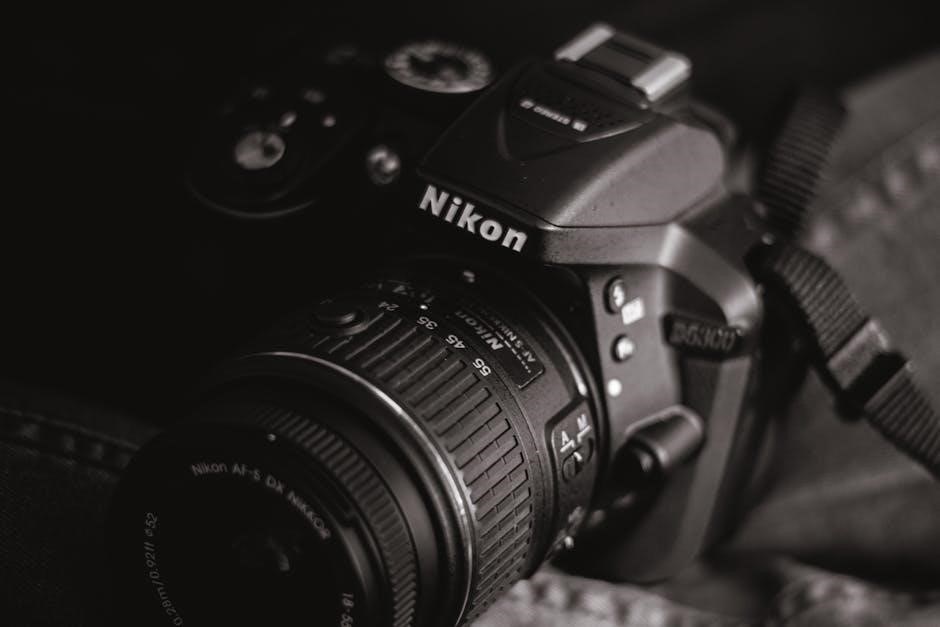
Parts Nomenclature
Understanding the Nikon F3’s components is essential for effective operation. The camera features a titanium honeycomb prism for durability‚ a rubberized grip for comfort‚ and a shutter speed dial with aperture and exposure controls. The interchangeable viewfinder and lens mount highlight its modular design‚ ensuring compatibility with a wide range of accessories.
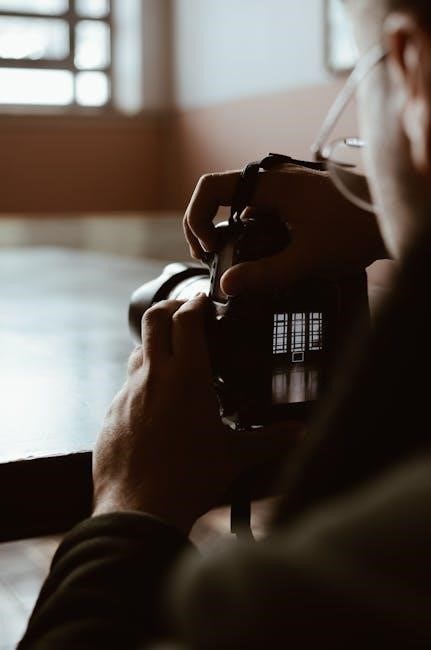
3.1 External Components
The Nikon F3’s external components are designed for durability and intuitive operation. The camera body is constructed from high-quality materials‚ including a titanium honeycomb prism for lightweight strength. The exterior features a rubberized grip for secure handling and a modular design that supports interchangeable viewfinders and lenses.
- Viewfinder: The standard DE-2 viewfinder provides a clear‚ bright view with 80% frame coverage and LED exposure meters for precise control.
- Lens Mount: The Nikon F-mount is compatible with a wide range of Nikkor lenses‚ offering flexibility for various shooting needs.
- Shutter Speed Dial: Located on the top plate‚ this dial allows manual control of shutter speeds from 8 seconds to 1/2000th of a second‚ plus a Bulb mode.
- Aperture Ring: Found on Nikkor lenses‚ it enables manual aperture adjustment‚ ensuring creative control over exposure.
- Exposure Compensation Dial: Positioned on the top plate‚ it permits ±3 stops of exposure adjustment for fine-tuning images.
- Battery Compartment: Located in the base‚ it houses four LR44 or SR44 batteries‚ ensuring reliable power for the camera’s electronic functions.
- Flash Sync Terminal: Positioned on the front of the camera‚ it supports external flash units for enhanced lighting control.
These external components are thoughtfully designed to enhance the photographer’s experience‚ combining functionality with ergonomic comfort.
3.2 Controls and Their Functions
The Nikon F3 features a range of intuitive controls designed to provide precise and efficient operation. These controls are strategically placed to ensure easy access during shooting.
- Shutter Speed Dial: Located on the top plate‚ this dial allows users to set shutter speeds from 8 seconds to 1/2000th of a second‚ as well as Bulb mode for long exposures. The dial is designed for smooth‚ click-free rotation.
- Aperture Ring: Found on Nikkor lenses‚ the aperture ring enables manual control of the aperture‚ offering creative control over depth of field and exposure.
- Exposure Compensation Dial: Positioned on the top plate‚ this dial provides exposure compensation of ±3 stops‚ allowing for fine adjustments to suit various lighting conditions.
- ISO Sensitivity Button: Located on the bottom of the camera‚ this button is used to set the ISO sensitivity of the film being used‚ ensuring proper exposure settings.
- Flash Sync Terminal: Positioned on the front of the camera‚ this terminal allows connection to external flash units for synchronized flash photography.
- Self-Timer Lever: Located on the front‚ this lever activates the self-timer‚ which delays the shutter release by 10 seconds to prevent camera shake during exposures.
- Film Advance Lever: Positioned on the top right‚ this lever is used to advance the film to the next frame. It also incorporates a film rewind crank for easy film retrieval.
- Meter Switch: Located on the top plate‚ this switch activates the built-in light meter‚ providing accurate exposure measurements in various lighting conditions.
Each control on the Nikon F3 is designed to enhance the shooting experience‚ offering precise functionality and ease of use for photographers of all skill levels.
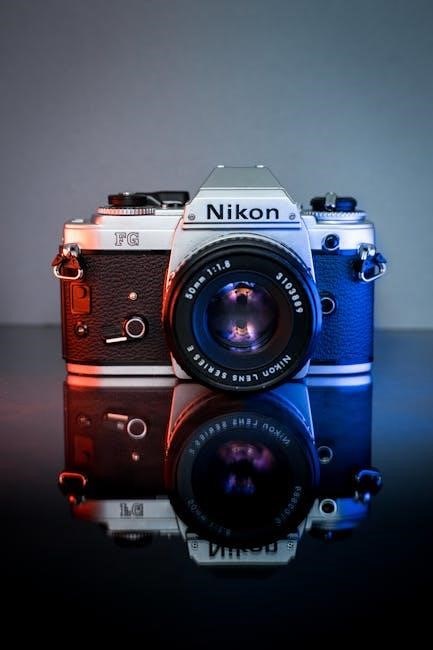
Basic Operation
The Nikon F3 operates with precision and simplicity. Load film‚ set shutter speed and aperture‚ focus using the viewfinder‚ and release the shutter. The camera’s intuitive design ensures smooth functionality‚ catering to both professionals and enthusiasts. Proper setup and adherence to manual guidelines are essential for optimal performance and image quality.
4.1 Powering On and Off
The Nikon F3 is powered by a 6V silver oxide battery (SR44 or equivalent)‚ ensuring reliable operation. To power on the camera‚ locate the ‘ON-OFF’ switch near the shutter release button. Rotate it clockwise to activate the camera. When not in use‚ turn the switch counterclockwise to the ‘OFF’ position to conserve battery life‚ which typically lasts for approximately 50 rolls of film.
The camera features a battery checker to monitor power levels. Press the battery check button to activate a small indicator‚ confirming the battery is functioning properly. Always use the correct battery type to maintain performance and avoid damage. Properly powering the camera is essential for smooth operation and extending its lifespan.
